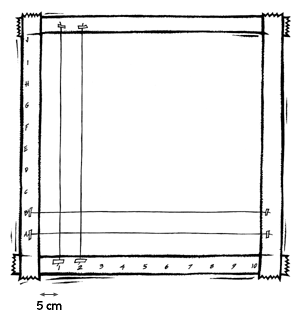Treasures of the Sunken City
|  |
Student Handout |
Tabletop Map
In this activity, you will build and then map a tabletop archeological site. A group of
fellow cartographers will need to use your map to recreate your site, so be
sure your logbook contains all the needed data. You've only got one
chance—there's no going back for a second look!
Part I

Begin by making a grid on the table-top that is approximately 50 cm x 50 cm
(20 in. x 20 in.) in size. Use four pieces of masking tape to create horizontal
and vertical axes. Using a ruler or measuring tape, begin at a corner where two
pieces of masking tape intersect and mark segments at 5 cm (2 in.) intervals
along each axis. Cut 20 pieces of thread that are 50 cm (20 in.) long. Tape a piece of string
securely at each segment mark to create a grid. (Tape both ends of the string
down.) Label each string along the horizontal axis with the numbers 1 through
10, and label the strings along the vertical axis with letters A through J. Gather 5 to 7 objects and place them in random positions on the grid. Just as
archeologists commonly find in excavations, be sure that some objects are
buried under others or layered on top of other objects. Use the sample chart to create a logbook to catalog your site's artifacts.
|
Dimensions
of object (height,
width, length)
|
Location (coordinate positions)
|
Relationship to other objects
|
Descriptions and unique characteristics
|
Object 1
|
|
|
|
|
Object 2
|
|
|
|
|
Object 3
|
|
|
|
|
etc...
|
|
|
|
|
Next, use the Artifact Mapping Grid, a pencil, and colored pencils to
create a coordinate map that shows the location of each object in your site. Be
sure to include ways to indicate layered objects and to provide directional
information so that others can orient your map.
Part II
Now that you've completed your map, it's time to put it to the test! Remove
objects from your site and place them next to the table. Exchange maps and
tables with another team. Use the other team's map to recreate the location of
each object on their site.
Questions
What elements of the other team's map were most useful in helping you
recreate their site? Which elements were least useful? Explain how using both the map and the logbook information provide a complete
picture of the site. Talk with team members that used your map to recreate your site. What did
they find useful about your map? What did they have questions about? What would
you change about your map based on their observations?
|
